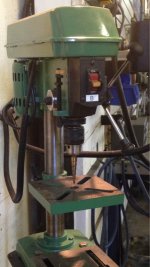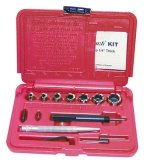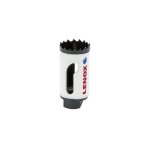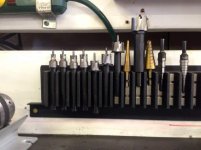BukitCase
Elite Member
- Joined
- Feb 17, 2012
- Messages
- 2,753
- Location
- Albany OR
- Tractor
- Case 580B, Long 460, Allis-Chalmers 160
SFM is Surface Feet per Minute - example - 1/2" drill bit, 240 rpm - a tooth on the bit travels just over 1.5" for each revolution (formula for circumference of a circle) - X 240 rpm = 360 linear INCHES per minute, divided by 12 = 30 SFM.
Here's a couple of links for more -
Machining Feeds and Speeds Calculator - Engineers Edge Engineering Calculator
Milling: Cutting Speeds & RPM Calculations
Some of that stuff is more for milling cutters but the idea is the same.
My drill press only goes down to 250 rpm and I've used it with up to 1" drill bits and 3" hole saws - the main thing is keeping feed rates up enough so you're getting good chips (drill bits) - also helps a LOT with bigger drills to drill a pilot hole about 1/4", then step up thru 2-3 sizes to the final size.
While annular cutters are great for bigger holes, they are very temperamental about side loading and very few drill presses for under $1000 are rigid enough NOT to break them. At prices from about $25 each up to several hundred$, they hold up a BUNCH longer when used with either a mag drill or a milling machine. Because they don't drill out all the metal but just a "fat hole saw" donut, they are several times as fast as large drill bits.
There are separate speed charts just for annular cutters. The biggest mistake made with these is NOT pushing them - you want a bit of color on the chips or you're not pushing hard enough. Too light a touch and you'll work harden the material and take the temper out of the cutter. $$$
One thing that's a necessity with hole saws is drilling a few holes (1/4" or so) around the inside perimeter of the saw track for filings to escape. Otherwise the saw will clog and you're done.
Another necessity is cooling - either a lube system or a large enough air compressor that you can keep a jet of air on the cutter throughout the cut - either way is messy, but doing neither will cost you a lot more in replaced (or sharpened) bits. NO free lunch here.
HTH... Steve
Here's a couple of links for more -
Machining Feeds and Speeds Calculator - Engineers Edge Engineering Calculator
Milling: Cutting Speeds & RPM Calculations
Some of that stuff is more for milling cutters but the idea is the same.
My drill press only goes down to 250 rpm and I've used it with up to 1" drill bits and 3" hole saws - the main thing is keeping feed rates up enough so you're getting good chips (drill bits) - also helps a LOT with bigger drills to drill a pilot hole about 1/4", then step up thru 2-3 sizes to the final size.
While annular cutters are great for bigger holes, they are very temperamental about side loading and very few drill presses for under $1000 are rigid enough NOT to break them. At prices from about $25 each up to several hundred$, they hold up a BUNCH longer when used with either a mag drill or a milling machine. Because they don't drill out all the metal but just a "fat hole saw" donut, they are several times as fast as large drill bits.
There are separate speed charts just for annular cutters. The biggest mistake made with these is NOT pushing them - you want a bit of color on the chips or you're not pushing hard enough. Too light a touch and you'll work harden the material and take the temper out of the cutter. $$$
One thing that's a necessity with hole saws is drilling a few holes (1/4" or so) around the inside perimeter of the saw track for filings to escape. Otherwise the saw will clog and you're done.
Another necessity is cooling - either a lube system or a large enough air compressor that you can keep a jet of air on the cutter throughout the cut - either way is messy, but doing neither will cost you a lot more in replaced (or sharpened) bits. NO free lunch here.
HTH... Steve



